Recent Posts
- Get HOMICIDE in four editions. Rated No.1 among The Five Best Crimes Biographies of All Time
- Peter Lance Biography
- HuffPost: DOJ report on MISSBURN case leaves out key detail: I.D. of the Mafia killer who broke the case for Hoover’s FBI
- On Halloween in 1994 CBS aired a new take on Orson Welles’ radio classic “War of The Worlds.” With 225,000+ views, it’s now become a YouTube cult favorite as well.
- Jason Leopold calls TRIPLE CROSS a “9/11 masterpiece”
Archives
- November 2025
- October 2025
- September 2025
- March 2025
- February 2025
- January 2025
- December 2024
- November 2024
- October 2024
- July 2024
- June 2024
- March 2024
- January 2024
- November 2023
- June 2023
- March 2023
- February 2023
- December 2022
- August 2022
- July 2022
- March 2022
- February 2022
- January 2022
- December 2021
- August 2020
- July 2020
- June 2020
- February 2020
- January 2020
- November 2019
- September 2019
- April 2019
- February 2018
- January 2018
- December 2017
- November 2017
- September 2017
- June 2017
- April 2017
- February 2017
- January 2017
- December 2016
- November 2016
- October 2016
- September 2016
- August 2016
- July 2016
- June 2016
- May 2016
- April 2016
- March 2016
- February 2016
- January 2016
- December 2015
- November 2015
- October 2015
- September 2015
- August 2015
- July 2015
- June 2015
- May 2015
- March 2015
- February 2015
- January 2015
- December 2014
- November 2014
- July 2014
- June 2014
- May 2014
- April 2014
- March 2014
- January 2014
- December 2013
- November 2013
- October 2013
- September 2013
- August 2013
- July 2013
- June 2013
- May 2013
- April 2013
- March 2013
- February 2013
- January 2013
- December 2012
- November 2012
- October 2012
- September 2012
- August 2012
- July 2012
- June 2012
- May 2012
- April 2012
- January 2012
- December 2011
- June 2011
- April 2011
- March 2011
- February 2011
- January 2011
- November 2010
- October 2010
- March 2010
- August 2009
- November 2006
- November 2004
- October 2003
- September 2003
- February 2000
Categories
- 1000 Years for Revenge
- ABC's Path to 9/11 issue
- Ali Mohamed
- Ali Mohamed revelations
- Anwar al-Awlaki
- ARCHIVES
- awards
- bio
- BIOGRAPHY
- BOOK TV C-SPAN2
- BOOK WRITING
- BOOKS
- Colombo family "war"
- Commentary
- DUI investigation
- Emad Salem investigation
- FBI ORGANIZED CRIME
- Featured
- FICTION
- First Degree Burn
- Fitzgerald censorship attempt
- Fitzgerald censorship scandal
- Fox News
- Gotham City Insider
- Gregory Scarpa Jr.
- Gregory Scarpa Jr.
- Gregory Scarpa Sr.
- Harpercollins
- HUFFINGTON POST
- INVESTIGATIONS
- Khalid Shaikh Mohammed
- MAGAZINE ARTICLES
- Major Hasan Fort Hood massacre
- MEDIA COVERAGE
- Meier Kahane Assassination
- Meir Kahane assassination
- Murder Inc.
- Nat Geo whitewash
- NEWSPAPER REPORTING
- NOVELS
- Oklahoma City bombing
- Omar Abdel Rahman
- OPERATION ABLE DANGER
- POLICE CORRUPTION
- Produced
- R. Lindley DeVecchio
- Ramzi Yousef
- Ramzi Yousef sting 302's
- REPORTING & ANALYSIS
- RESEARCH
- Santa Barbara News-Press
- SCREENWRITING
- Stranger 456
- Stranger 456
- teleplays
- Tenacity Media
- Triple Cross
- Triple Cross
- TV NEWS COMMENTARY
- Uncategorized
- videos
- WIKIPEDIA
Murder, Inc. the true crime classic. Republished with a new Foreword by Peter Lance
![Murder-Inc.-graphic-for-website-lead[1]](http://peterlance.com/wp-content/uploads/2012/06/Murder-Inc.-graphic-for-website-lead1.png) FOREWARD to the new edition By Peter Lance
FOREWARD to the new edition By Peter Lance
I was first introduced to Murder Inc., by Nick Pileggi, the extraordinary journalist, author and screenwriter responsible for two of the most iconic works in the literature of organized crime: Wiseguy, which he adapted into the film Goodfellas and Casino; also brought to the screen in collaboration with Martin Scorsese.
Along with Mario Puzo’s The Godfather (Parts I & II) directed by Francis Ford Coppola, the Pileggi-Scorsese collaborations stand as a kind of filmic Blessed Trinity which help us to understand the underworld association that J. Edgar Hoover called La Cosa Nostra.
But long before the New York “five families” took shape in their present configurations: Gambino, Genovese, Colombo, Lucchese and Bonnano, there was an organization of Italian and Jewish gangsters which the newspapers of the 1940’s branded “The Syndicate.” It was criminal enterprise dominated by Charles “Lucky” Luciano, Meyer Lansky, Albert Anastasia, Benjamin “Bugsy” Siegel, Joe Adonis and Louis “Lepke” Buchalter – an informal “board of directors” known as “The Big Six.”
Identifying themselves as “The Combination,” this axis of Jewish and Italian gangsters who associated above and apart from the traditional rules of The Mafia, reaped millions of dollars a year in the post-Prohibition decades from gambling, labor racketeering, extortion, prostitution and dope peddling, but their most lethal product was homicide.
Operating out of Midnight Rose’s, a candy story under the El tracks on the corner of Saratoga and Livonia Avenues in Brownsville, Brooklyn, “Murder, Inc..” as it was dubbed by World-Telegram reporter Harry Feeney, was a twenty-four-hour-a day-racket that killed more than a thousand people from coast to coast during the 1930’s and early ‘40’s.
Located less than two miles from Ebbets Field where the Dodgers played, the candy store was dominated by Abe “Kid Twist” Reles – so named for his skill at strangling victims. There was a pay phone in the back of the story and when a “contract” was called in, the killers, designated by Reles, would be dispatched with a doctor’s bag containing the three possible weapons of choice: a gun, an ice pick and a garrote.
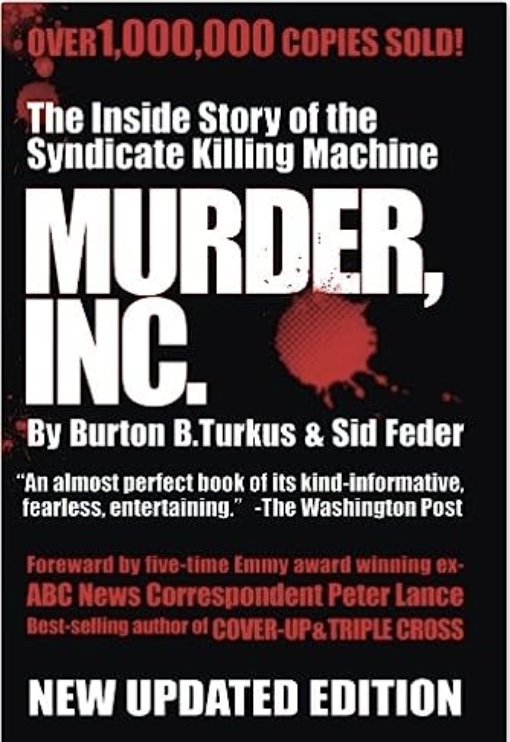 TAKING MOTIVE OUT OF MURDER
TAKING MOTIVE OUT OF MURDER
Like traveling salesmen, the killers would then hop on a train and ride to the destination, which was typically a city in the Midwest or South. On arrival they would “case” the victim, do the job and be back on the train before the police had time to put a chalk mark on the ground. Naturally, the “contractor” who had first placed the call, would have an ironclad alibi for the time of the extermination. With this heinous, but brilliant scheme, Reles and his “Brownsville Boys” took motive out of the murder equation.
The crew of rubout specialists was as colorful a gang as ever wielded an ice pick. There was Vito Gurino, an apelike torpedo who practiced sharp-shooting by blasting the heads off chickens; Buggsy Goldstein, Dasher Abandando and Happy Maione, named for the permanent grimace that always crossed his face.
The senior shooter was Harry “Pittsburgh Phil” Strauss, a handsome clothes horse who killed more than thirty men in a dozen cities. But the beetle-browed Reles was the boss of the enterprise and no one outside the underworld had a clue to the bloodthirsty “death on demand” racket he ran, until he was ultimately arrested and turned by Burton B. Turkus.
A former defense lawyer with the suave looks of Errol Flynn, the courtroom manner of William Powel and a steel-trap legal mind, Turkus agreed to go to work for Brooklyn D.A. William O’Dwyer, a former judge, after a string of 200 unsolved murders piled up in Kings County. Quickly assembling a crack team of lawyers and detectives, Turkus turned up the heat and eventually “flipped” Kid Twist into the most famous mob “canary” in history – that is until Joseph Valachi “sang” to the McClellan committee twenty years later.
 Turkus was astonished to learn from Reles that those 200 homicides were just the tip of the “ice pick,” so to speak, and that under the direction of the “Big Six,” motivated primarily by Lepke Buchalter – another 800 bodies were scattered nationwide – all linked back to Midnight Rose’s and The Brownsville Boys.
Turkus was astonished to learn from Reles that those 200 homicides were just the tip of the “ice pick,” so to speak, and that under the direction of the “Big Six,” motivated primarily by Lepke Buchalter – another 800 bodies were scattered nationwide – all linked back to Midnight Rose’s and The Brownsville Boys.
But how Turkus ultimately nailed Lepke is a roller coaster ride of ups and downs.
On the eve of his testimony against Buchalter for the murder of garment district owner Joseph Rosen, Reles, who had been protected in “The Squealer’s Suite” of the Half Moon Hotel on Coney Island, was thrown to his death. Although corrupt police officers later claimed that he slipped during an escape attempt, the evidence clearly pointed to homicide and Reles was forever known as “The Canary Who Sang But Didn’t Know How to Fly.”
The page-turning story of how Turkus recovered from that setback and eventually sent Lepke to the electric chair in Sing Sing – the first and only mob boss in history to die in a government execution – was chronicled by Sid Feder, a former war correspondent who spent 17 years as a veteran reporter for the Associated Press.
Told in Turkus’s own first-person voice, Murder, Inc, The Story of The Syndicate, was first published by Farrar, Strauss & Young in 1951 and quickly became a runaway best seller worldwide. It was adapted into a film in 1961 which starred Peter Falk in his debut role as Reles and by 1974 “Murder, Inc.” had sold more than a million copies. Meanwhile, Burton Turkus went onto become one of the most successful labor negotiators in New York history.
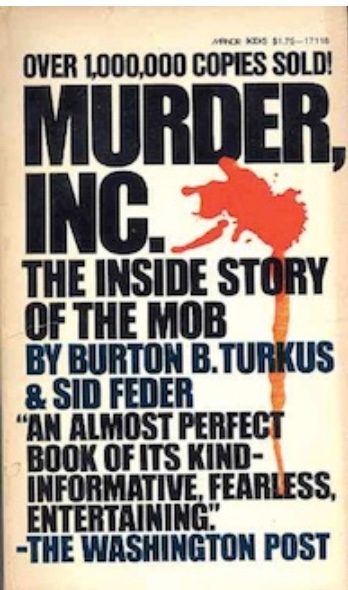 I had done a number of organized crime-related stories in my days as an investigative correspondent for ABC News, but had never touched on Murder, Inc. Then in 1998 when Nick Pileggi began collaborating with the late Michael King (of King World) to adapt the Turkus-Feder book as an NBC mini-series I was hired to write the six hours of teleplays.
I had done a number of organized crime-related stories in my days as an investigative correspondent for ABC News, but had never touched on Murder, Inc. Then in 1998 when Nick Pileggi began collaborating with the late Michael King (of King World) to adapt the Turkus-Feder book as an NBC mini-series I was hired to write the six hours of teleplays.
Devouring both the book and hundreds of Murder Incorporated news clips that Nick had obtained, I ended up turning in seven hours of material. But at the time, NBC decided to get out of the mini-series business so the scripts remained un-produced.
TERRORISM AND ORGANIZED CRIME
Flashing forward to 2001, I returned to investigative journalism right after the attacks of 9/11 and began what turned into a twelve year investigation into the counter-terrorism record of the FBI in the years leading up to “September 11th” and beyond. The work culminated in my trilogy for HarperCollins: 1000 Years for Revenge: International Terrorism and the FBI, Cover Up: What the Government is Still Hiding About the War on Terror and Triple Cross: How bin Laden’s Master Spy Penetrated the CIA, the FBI and The Green Berets. (www.peterlance.com).
As could only happen in New York, in the course of my research for Cover Up I learned of an extraordinary nexus between a pair of al Qaeda terrorists and a member of organized crime. In 1996 while awaiting trial on the ninth floor tier of the Metropolitan Correctional Center (M.C.C.) the federal jail in Lower Manhattan, Gregory Scarpa Jr. a capo for the Colombo crime family, found himself in a cell between Ramzi Yousef, the al Qaeda bomb maker responsible for the 1993 World Trade Center bombing and Abdul Hakim Murad, a Kuwaiti pilot who had been trained in four U.S. flight schools.
In 1000 Years for Revenge, I proved that after fleeing New York following the WTC bombing on February 26th, 1993, Yousef set up a cell in the Philippines along with Murad, an Uzbeki named Wali Khan Amin Shah (beloved by Osama bin Laden) and Yousef’s uncle, Khalid Shaikh Mohamed (KSM) a man who would not be forgotten by history. 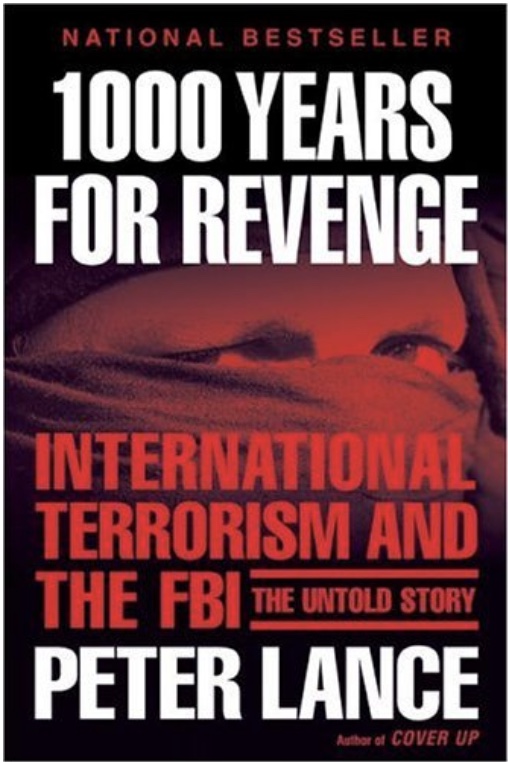
By the late fall of 1994 the brilliant but twisted Yousef, had conceived of three plots: first the assassination of Pope John Paul II who was to be in Manila in January, 1995 and second, the so-called “Bojinka” plot to smuggle a series of improvised explosive devices (IED’s) on board the first legs of a dozen U.S. airline flights bound from Asia to the States. This non-suicide plot called for the co-conspirators to disembark as the airliners landed in second leg Asian cities, only to have the planes explode over the Pacific hours later.
But Yousef’s most ambitious plot, to be headed by Murad as lead pilot, was to hijack a series of airliners in the U.S. and use them as missiles aimed at the WTC, the Pentagon, CIA Headquarters in Langley, Virginia, the Sears & Transamerica Towers and an unnamed nuclear facility. This plot known as “the planes operation” was interdicted after a fire in Yousef’s bomb factory on the night of January 5th, 1995. Yousef and KSM then fled to Islamabad, Pakistan, but Murad was captured by the Philippines National Police (PNP).
He was later interrogated by Col. Rodolfo B. Mendoza of the PNP who uncovered the “planes as missiles” plot and communicated it back to Federal prosecutors in the Southern District of New York (SDNY) after Yousef was captured and rendered back for trial along with Murad and Wali Khan. The one member of the Manila cell who remained at large was KSM, whom we now know perfected Yousef’s murderous plot using Mohammed Atta as a stand-in for Murad on 9.11.01.
“THE KILLING MACHINE”
In the course of my research I uncovered dozens of FBI 302 memos documenting a sting by Greg Scarpa Jr. that was authorized by the FBI in which the mobster intercepted a series of notes from Yousef including threats to hijack planes and plant bombs on U.S. airliners so that he could achieve a mistrial in the prosecution of the “Bojinka” plot which the Feds decided to try first, in the summer of 1996, before the WTC bombing case. Many of those 302’s can be accessed HERE:
One piece of intelligence from Scarpa Jr. was worth its weight in platinum – the location of KSM who was hiding out in Doha Qatar. But by the time the FBI sent its elite Hostage Rescue Team (HRT) to nab him, KSM had escaped only to succeed on 9/11 in doing what his nephew had failed to do in 1993 — take down the Twin Towers.
 Later after Federal prosecutors decided to bury what became known as “The Scarpa Materials” – the intelligence contained in those 302s – I began working on my fourth HarperCollins book “Deal With The Devil,” which was initially called SIX SIX SIX. That title derived from the Satanic digits: 6-6-6 which Greg Jr.’s father Gregory Senior would punch into the beeper of his consigliere each time he committed a murder. As I began to dig deeper, I learned that Scarpa Sr. was a one-man Mafia successor to “Murder Inc.” In 42 years as a soldier and capo in the Colombos, Senior, who was known as “The Grim Reaper,” committed more than 50 homicides.
Later after Federal prosecutors decided to bury what became known as “The Scarpa Materials” – the intelligence contained in those 302s – I began working on my fourth HarperCollins book “Deal With The Devil,” which was initially called SIX SIX SIX. That title derived from the Satanic digits: 6-6-6 which Greg Jr.’s father Gregory Senior would punch into the beeper of his consigliere each time he committed a murder. As I began to dig deeper, I learned that Scarpa Sr. was a one-man Mafia successor to “Murder Inc.” In 42 years as a soldier and capo in the Colombos, Senior, who was known as “The Grim Reaper,” committed more than 50 homicides.
He ruled the streets of Brooklyn, like a bloodthirsty feudal lord, making hundreds of millions of dollars through, drug dealing, loansharking, hijacking, high-end stock fraud, stolen credit cards, gambling and sophisticated bank robberies that often netted millions a single score. After only serving 30 days in more than four decades of murder and mayhem, Scarpa Sr. earned another nickname: “The Killing Machine,” which, ironically was the way Abe Reles had identified Murder Incorporated for Burton Turkus.
THE MACHIAVELLIAN STRATEGIST
Knowing what I knew about the “Brooklyn Combination” and suspicious about the motives of the Feds in discrediting Scarpa Jr.’s Yousef intelligence, I began to pull back the layers and found shocking evidence that the reason Scarpa Sr. was able to operate for so long with such murderous impunity, was because he was being protected by the Bureau.
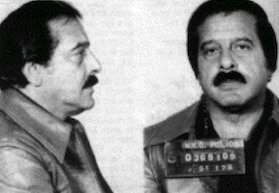 Beginning in 1960 and for the next 32 years, Senior operated as a snitch for the FBI. His debriefings on the Colombo borgata and the other four families in New York went directly to every FBI director starting with Hoover himself who designated Scarpa Sr. as a TECI: a Top Echelon Criminal Informant in 1962. After years of digging I was able to find 1,153 pages of heretofore secret files documenting the FBI’s clandestine relationship with Scarpa Sr. who was designated in FBI files as: NY 3461 or “34” for short.
Beginning in 1960 and for the next 32 years, Senior operated as a snitch for the FBI. His debriefings on the Colombo borgata and the other four families in New York went directly to every FBI director starting with Hoover himself who designated Scarpa Sr. as a TECI: a Top Echelon Criminal Informant in 1962. After years of digging I was able to find 1,153 pages of heretofore secret files documenting the FBI’s clandestine relationship with Scarpa Sr. who was designated in FBI files as: NY 3461 or “34” for short.
The evidence proved that much of the FBI’s view of La Cosa Nostra (LCN) was dictated by Gregory Sr. who wasn’t just a wiseguy killer but a Machiavellian strategist who had succeeded over the years in knocking off (by murder or indictment) all of the competition above him in the Colombo family from Joe Colombo, the boss, to his successor Carmine “The Snake” Persico to Vic Orena Sr. the acting boss in the early 1990’s when Senior himself touched off a war in an effort to takeover of the borgata. It was a conflict on the streets of Brooklyn that left at least 14 dead including two innocent bystanders and six of the hits were executed by Senior himself or on his direct orders.
Perhaps more disturbing I documented 25 separate murders during the 12 year period Scarpa Sr. was being “controlled” by his last contacting agent ex-Supervisory Special Agent R. Lindley DeVecchio, a Bureau veteran who ran two O.C. squads in New York and taught informant development at the FBI Academy in Quantico, Virginia.
THE “UNHOLY ALLIANCE”
I then went back and used “Deal With The Devil” to tell the extraordinary story of the Colombo family from 1950 when Scarpa Sr. first got “straightened out,” up through the third war in the borgata which had experienced the most violence of any in the New York Commission. It’s clear now that the body count was largely the result of the fact that Scarpa Sr. acted as an effective agent provocateur– wreaking havoc with the intel he derived from his special Top Echelon status.
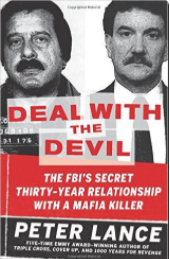 But if Gregory Scarpa Sr., “The Killing Machine” was a one-man Murder Inc. the consequences of his homicide spree had an entirely different outcome at the hands of the Brooklyn D.A. than occurred in the 1940’s when Burt Turkus was prosecuting Lepke and company. In 2005 after I first published evidence of what defense lawyers described as the “unholy alliance” between Scarpa Sr. and Lin DeVecchio, Kings County D.A. Charles Hynes commenced an investigation which resulted in DeVecchio’s indictment in March of 2006 on four counts of homicide relating to rubouts by “34.”
But if Gregory Scarpa Sr., “The Killing Machine” was a one-man Murder Inc. the consequences of his homicide spree had an entirely different outcome at the hands of the Brooklyn D.A. than occurred in the 1940’s when Burt Turkus was prosecuting Lepke and company. In 2005 after I first published evidence of what defense lawyers described as the “unholy alliance” between Scarpa Sr. and Lin DeVecchio, Kings County D.A. Charles Hynes commenced an investigation which resulted in DeVecchio’s indictment in March of 2006 on four counts of homicide relating to rubouts by “34.”
But after a truncated two week trial in the fall of 2007 the case fell apart and the charges against DeVecchio were dismissed. From 1994-1996 the ex-Supervisory Special agent had been investigated by the FBI’s Office of Professional Responsibility. This “internal affairs” probe began after multiple agents under DeVecchio in the C-10 Colombo squad, disclosed that lethal intelligence had found its way to their boss’s star informant Greg Scarpa Sr.
During the course of the OPR investigation DeVecchio refused a polygraph, took the Fifth and was granted immunity by the Justice Department. In fact, after the FBI closed the investigation he got immunity a second time and answered “I don’t recall,” or words to that effect, more than 50 times during a 1997 examination by defense lawyers who sought to get at the truth behind his secret relationship with “The Grim Reaper.”
We can only wonder what DeVecchio’s fate might have been, if the tenacious Burton Turkus was trying the case for the Brooklyn D.A.’s office and Sid Feder had been around to chronicle the action. In any event, in the following pages, readers of this updated new edition will find a unique and fascinating behind-the-scenes look at what it took to untangle the web of a thousand murders and bring the gangster-killers responsible to justice.
The paperback edition of “Deal With The Devil” hit bookstores in 2014. In the meantime, sit back and enjoy the remarkable story of Burton Turkus, a prosecutor so feared by the Syndicate that they called him “Mr. Arsenic.” It’s an organized crime saga that begs to find it way, once again, to the screen.


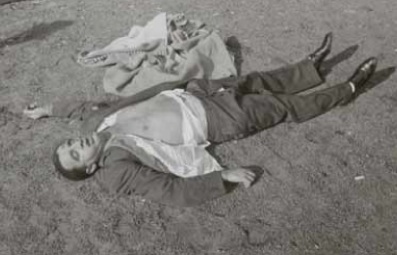


Recent Comments